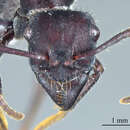en
names in breadcrumbs


Clypeus sehr niedrig, zwischen dem Fuehlerursprunge mit zwei halbkugelfoermigen Erhoehungen, unter denen die Gelenkskoepfe der Fuehler liegen; Pronotum oben beiderseits mit einem Zahne, unten beiderseits ohne Zahn; Metanotum mit zwei Zaehnen; Thorax zwischen dem Meso- und Metanotum stark eingeschnuert. Stielchen mit einer queren dicken, unbewehrten Schuppe.
Head subquadrate; antennae inserted forwards on the face at the base of the clypeus, 12-jointed in the female, 13-jointed in the male; eyes ovate and very prominent, placed a little behind the middle at the sides of the head; maxillary palpi 2-jointed, labial palpi 2-jointed; mandibles triangular, with one or two minute teeth near their apex. Thorax: wings with one marginal and three submarginal cells, the second submarginal cell receiving the recurrent nervure near its base; legs elongate, the spur which arms the apex of the intermediate and posterior tibiae simple, that at the apex of the anterior pair pectinate within. Abdomen: the node of the peduncle incrassate, a deep strangulation between the first and second segments.
Ectatomma is a Neotropical genus of ants in the subfamily Ectatomminae. The genus contains 17 described extant species and one extinct species.[2]
Ectatomma is one of the most common genera in the Neotropical region,[3] with most species being South American in their distribution, but others can be found in Central America as well as sparse populations in the Caribbean. Ectatomma may be found in rainforests, savannas, dry environments and cultivated areas.[4]

Ectatomma is a Neotropical genus of ants in the subfamily Ectatomminae. The genus contains 17 described extant species and one extinct species.